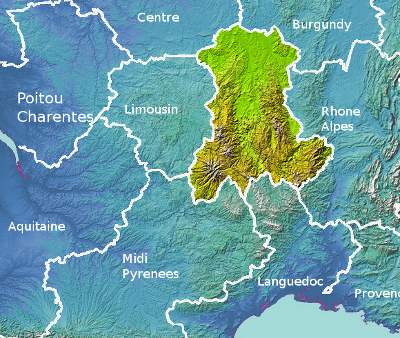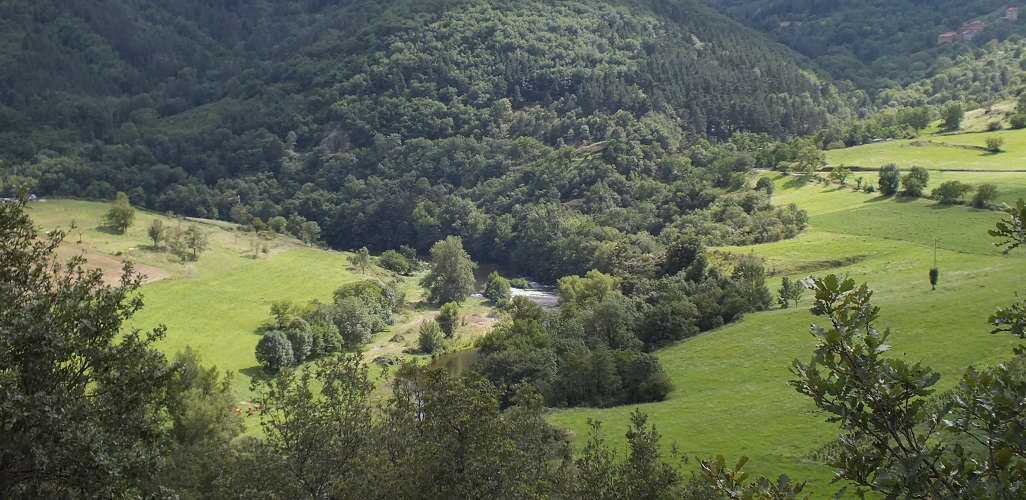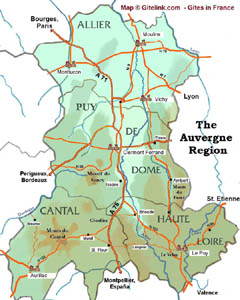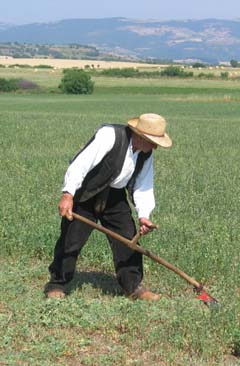An
inside guide to Auvergne
 Auvergne is one of France's
hidden treasures,
Auvergne is one of France's
hidden treasures,
a region of hills and mountains, valleys, forests and rivers, a region
where - except for the regional capital, Clermont Ferrand - the hustle
of city life is something unknown, and time seems to move at
a
slower and much more agreeable pace.....
The mountains of Auvergne, which culminate in rocky peaks at over 1700m
/ 7000
feet, are the backbone of France's Massif Central. This area of
highland is the
largest
volcanic area in Europe.
As the experts stress, the volcanoes are dormant... though not extinct.
There is plenty of volcanic activity going on deep below the ground, as
is still seen by the hot springs at Chaudes Aigues in the Cantal, where
the water comes out of the ground at a temperature of 82°C, the
hottest
springs in Europe. Nonetheless, there is little reason for alarm, as
there has been no volcanic activity in Auvergne for over 7000 years.
Traces of the volcanic past are however to be seen throughout the
region, not just in the form of the volcanoes themselves, but in the
numerous lava flows, volcanic plugs - often capped with castles
-
and sets of "organ rocks" that form one of the region's
remarkable geological features.
While the northern end of the province stretches
up the
Loire
and
Allier
valleys towards the low-lying Centre of France, most of the southern
part of the region is hilly or mountainous, with large stretches of
land lying at over 1000 metres (over 3000 ft). These uplands are
penetrated by the valleys of many rivers, most notably the Loire and
the Allier which both rise in the south of the Auvergne.
Sparsely populated, the Auvergne boasts a fine
natural and cultural heritage,
including beautiful valleys, large expanses of coniferous forests, and
spectacular hillscapes. It is a region much appreciated by ramblers and
nature lovers, as well as by people in search of a holiday far from the
madding crowd.
It is a region rich in history too, with a fine
collection
of historic dungeons and castles, as well as some of the finest
romanesque churches in France, many with frescoes. The small city of
Le
Puy,
famous for its lace-making and UNESCO listed cathedral, is one of the
most unusual cities in
France, due to the rocky pinnacles that stick up in the middle of it.
Other interesting towns to visit in Auvergne
include the "art and history" city of
Brioude,
the French knife-making capital of
Thiers,
the genteel spa town of
Vichy,
and the capital of "High Auvergne"
Saint Flour, among others
Of course there are modern attractions too,
including a safari park,
the Vulcania
theme park (illustrating the story of Auvergne's extinct volcanoes, and
including 3-D cinema and IMAX), scenic railway lines, cable cars to the
peaks of the highest mountains, kayaking and rafting facilities,
mountain bike tracks, and much more. The
Auvergne Wildlife Park
at Ardes sur Couze, near Issoire, is also worth a visit.
Three main rivers have their headwaters in the
Auvergne: the Loire, the Allier and the Dordogne.
Clermont
Ferrand, Auvergne's capital city, is a university city of
some 200,000 inhabitants, and the home of the
Michelin Tyre
Company. It is a busy shopping centre, with plenty of cultural life,
Travel information - Access to Auvergne
:
Though the region is not served directly by any year-round
low-cost
airline services, Auvergne is an accessible area, and just that little
bit closer to Britain, Paris or the north of Europe than the
southwest of France and the Mediterranean regions, which it borders to
the south and west.
 By AIR
By AIR:
The Clermont Ferrand airport has direct flights with many
destinations in France and a few beyond. Low-cost airline Ryanair fly
to Clermont Ferrand from London Stansted in the summer.
Other nearby airports served by low-cost carriers are Limoges
and
Rodez in the west, and Lyon in the east.
 By ROAD
By ROAD:
By road, destinations in the Auvergne are from about 7 to 9 hours'
drive from Calais or Brussels, and 4 from Paris. The new motorway link
between Paris and Spain, via the magnificent Millau viaduct,
passes through the heart of the Auvergne (A 71 in the north, A 75 in
the south). The A 89 motorway is an east-west link providing easy
access to the Auvergne from Lyon and Bordeaux.

By
RAIL:
Fast Intercités express trains run between Clermont Ferrand
and
Paris, via Vichy and Moulins, in three and a half hours. Clermont
Ferrand
also has direct services to Lyon (just over two and a half hours), and
rather slow but very picturesque direct services to Nimes and to
Beziers.
Le Puy en Velay is best reached from Paris by TGV to Saint Etienne, and
local train through the Loire gorges thereafter.
 By CYCLE
By CYCLE :
The Auvergne is crossed from north to south by
French national cycleway V70.
This runs from its junction with the east-west European cycle route EV6
(Danube to the Atlantic) at Cuffy, just south of Nevers (Burgundy), to
the Mediterranean coast south of Montpellier. The Auvergne section of
V70 is due for almost complete opening in 2020; basically it follows
the valley of the river Allier from near its confluence with the Loire
near Nevers, to Pradelles, just north of Langogne, and close to the
river's source. It passes through Moulins, Saint-Pourçain,
Vichy, Vic
le Comte, Auzon, Brioude, Langeac and Monistrol d'Allier. Following the
river Allier almost up to its source, It is the easiest of the
north-south cycle routes to the Mediterranean. South of Pradelles,
cyclists can follow relatively traffic-free routes through Langogne,
then the D906 which slopes gently down from the Col du Thort towards
Villefort and on to the Mediterranean plains.
 On FOOT
On FOOT :
The Auvergne is one of the major hubs of the French national
long-distance hiking trail network, the sentiers de Grande
Randonnée.
See
hiking
trails in France.

The
Limagne and the
plains in the north of the region.

The
Monts du Forez in
the east of the region, a long chain of uplands broadening out into a
high plateau at their southern end.

The
Volcanoes,
craggy peaks bursting through the uplands between the Puy de Dome
beside Clermont Ferrand and the Plomb du Cantal in the south west.

The
Cezallier, high
prairie land stretching southwards from the Massif du Sancy, famous for
its open spaces, cattle grazing and cheeses.

The
Haut
Allier - where
the Allier and its tributaries emerge from the
uplands in deep valleys.

The
Velay - the high
plateau around the town of Le Puy, between the Forez to the north and
the Cevennes to the south.

The
mountains of the
Margeride,
dividing
the Cantal from the Haute Loire.

The rest
of the
Cantal
uplands, in
the south of the department of this name.
 Hiking and mountain biking
Hiking and mountain biking
almost anywhere in the region
 Kayaking and water sports
Kayaking and water sports on the Allier and the Loire.
 Fishing
Fishing, coarse and fly, on most of the region's
rivers.
 Hang gliding
Hang gliding from the volcanoes.
 Downhill skiing
Downhill skiing on the Puy de Sancy and the Plomb du
Cantal (fully equipped resorts).
 Nordic skiing
Nordic skiing in many places.





 Auvergne
guide
Auvergne
guide The
Departments / counties
The
Departments / counties Auvergne food and drink
Auvergne food and drink Things to see and do in
Auvergne
Things to see and do in
Auvergne The
Auvergne in figures
The
Auvergne in figures Auvergne holiday cottages
Auvergne holiday cottages Auvergne is one of France's
hidden treasures,
a region of hills and mountains, valleys, forests and rivers, a region
where - except for the regional capital, Clermont Ferrand - the hustle
of city life is something unknown, and time seems to move at
a
slower and much more agreeable pace.....
Auvergne is one of France's
hidden treasures,
a region of hills and mountains, valleys, forests and rivers, a region
where - except for the regional capital, Clermont Ferrand - the hustle
of city life is something unknown, and time seems to move at
a
slower and much more agreeable pace.....  By AIR:
The Clermont Ferrand airport has direct flights with many
destinations in France and a few beyond. Low-cost airline Ryanair fly
to Clermont Ferrand from London Stansted in the summer.
Other nearby airports served by low-cost carriers are Limoges
and
Rodez in the west, and Lyon in the east.
By AIR:
The Clermont Ferrand airport has direct flights with many
destinations in France and a few beyond. Low-cost airline Ryanair fly
to Clermont Ferrand from London Stansted in the summer.
Other nearby airports served by low-cost carriers are Limoges
and
Rodez in the west, and Lyon in the east. By ROAD:
By road, destinations in the Auvergne are from about 7 to 9 hours'
drive from Calais or Brussels, and 4 from Paris. The new motorway link
between Paris and Spain, via the magnificent Millau viaduct,
passes through the heart of the Auvergne (A 71 in the north, A 75 in
the south). The A 89 motorway is an east-west link providing easy
access to the Auvergne from Lyon and Bordeaux.
By ROAD:
By road, destinations in the Auvergne are from about 7 to 9 hours'
drive from Calais or Brussels, and 4 from Paris. The new motorway link
between Paris and Spain, via the magnificent Millau viaduct,
passes through the heart of the Auvergne (A 71 in the north, A 75 in
the south). The A 89 motorway is an east-west link providing easy
access to the Auvergne from Lyon and Bordeaux. By RAIL:
Fast Intercités express trains run between Clermont Ferrand
and
Paris, via Vichy and Moulins, in three and a half hours. Clermont
Ferrand
also has direct services to Lyon (just over two and a half hours), and
rather slow but very picturesque direct services to Nimes and to
Beziers.
By RAIL:
Fast Intercités express trains run between Clermont Ferrand
and
Paris, via Vichy and Moulins, in three and a half hours. Clermont
Ferrand
also has direct services to Lyon (just over two and a half hours), and
rather slow but very picturesque direct services to Nimes and to
Beziers.  By CYCLE :
The Auvergne is crossed from north to south by French national cycleway V70.
This runs from its junction with the east-west European cycle route EV6
(Danube to the Atlantic) at Cuffy, just south of Nevers (Burgundy), to
the Mediterranean coast south of Montpellier. The Auvergne section of
V70 is due for almost complete opening in 2020; basically it follows
the valley of the river Allier from near its confluence with the Loire
near Nevers, to Pradelles, just north of Langogne, and close to the
river's source. It passes through Moulins, Saint-Pourçain,
Vichy, Vic
le Comte, Auzon, Brioude, Langeac and Monistrol d'Allier. Following the
river Allier almost up to its source, It is the easiest of the
north-south cycle routes to the Mediterranean. South of Pradelles,
cyclists can follow relatively traffic-free routes through Langogne,
then the D906 which slopes gently down from the Col du Thort towards
Villefort and on to the Mediterranean plains.
By CYCLE :
The Auvergne is crossed from north to south by French national cycleway V70.
This runs from its junction with the east-west European cycle route EV6
(Danube to the Atlantic) at Cuffy, just south of Nevers (Burgundy), to
the Mediterranean coast south of Montpellier. The Auvergne section of
V70 is due for almost complete opening in 2020; basically it follows
the valley of the river Allier from near its confluence with the Loire
near Nevers, to Pradelles, just north of Langogne, and close to the
river's source. It passes through Moulins, Saint-Pourçain,
Vichy, Vic
le Comte, Auzon, Brioude, Langeac and Monistrol d'Allier. Following the
river Allier almost up to its source, It is the easiest of the
north-south cycle routes to the Mediterranean. South of Pradelles,
cyclists can follow relatively traffic-free routes through Langogne,
then the D906 which slopes gently down from the Col du Thort towards
Villefort and on to the Mediterranean plains.  On FOOT :
The Auvergne is one of the major hubs of the French national
long-distance hiking trail network, the sentiers de Grande
Randonnée.
See hiking
trails in France.
On FOOT :
The Auvergne is one of the major hubs of the French national
long-distance hiking trail network, the sentiers de Grande
Randonnée.
See hiking
trails in France. The Limagne and the
plains in the north of the region.
The Limagne and the
plains in the north of the region. The Monts du Forez in
the east of the region, a long chain of uplands broadening out into a
high plateau at their southern end.
The Monts du Forez in
the east of the region, a long chain of uplands broadening out into a
high plateau at their southern end. The Volcanoes,
craggy peaks bursting through the uplands between the Puy de Dome
beside Clermont Ferrand and the Plomb du Cantal in the south west.
The Volcanoes,
craggy peaks bursting through the uplands between the Puy de Dome
beside Clermont Ferrand and the Plomb du Cantal in the south west. The Cezallier, high
prairie land stretching southwards from the Massif du Sancy, famous for
its open spaces, cattle grazing and cheeses.
The Cezallier, high
prairie land stretching southwards from the Massif du Sancy, famous for
its open spaces, cattle grazing and cheeses. The Haut
Allier - where
the Allier and its tributaries emerge from the
uplands in deep valleys.
The Haut
Allier - where
the Allier and its tributaries emerge from the
uplands in deep valleys. The Velay - the high
plateau around the town of Le Puy, between the Forez to the north and
the Cevennes to the south.
The Velay - the high
plateau around the town of Le Puy, between the Forez to the north and
the Cevennes to the south. The
mountains of the Margeride,
dividing
the Cantal from the Haute Loire.
The
mountains of the Margeride,
dividing
the Cantal from the Haute Loire. The rest
of the Cantal
uplands, in
the south of the department of this name.
The rest
of the Cantal
uplands, in
the south of the department of this name. Hiking and mountain biking
almost anywhere in the region
Hiking and mountain biking
almost anywhere in the region Kayaking and water sports on the Allier and the Loire.
Kayaking and water sports on the Allier and the Loire. Fishing, coarse and fly, on most of the region's
rivers.
Fishing, coarse and fly, on most of the region's
rivers. Hang gliding from the volcanoes.
Hang gliding from the volcanoes. Downhill skiing on the Puy de Sancy and the Plomb du
Cantal (fully equipped resorts).
Downhill skiing on the Puy de Sancy and the Plomb du
Cantal (fully equipped resorts). Nordic skiing in many places.
Nordic skiing in many places.




